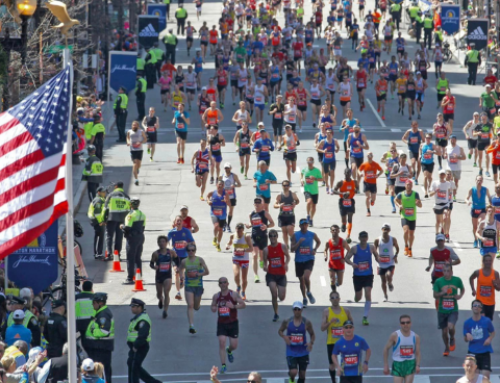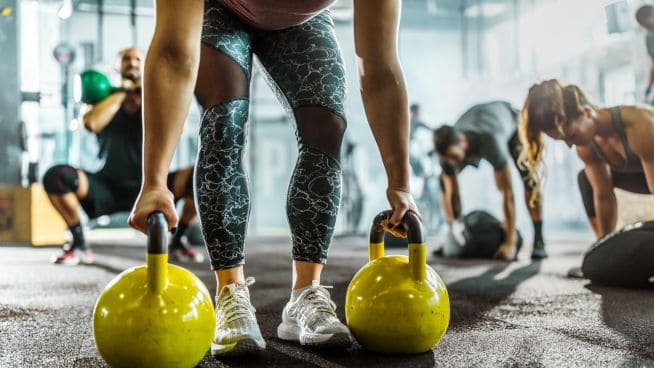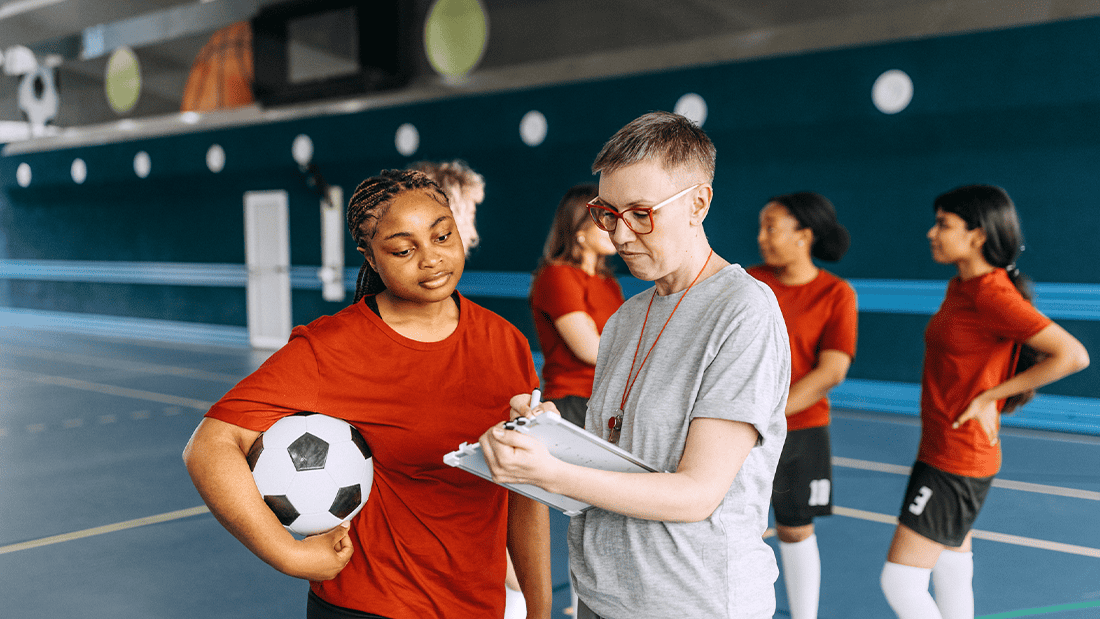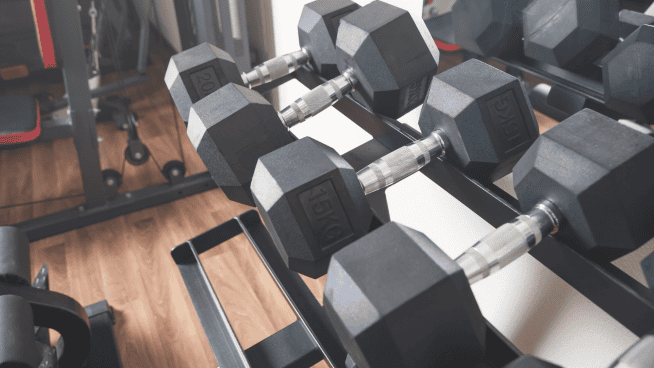![]()
The offensive line is the lifeblood of every football team, but let’s face it, the big guys up front rarely get any glory. For the most part, playing on the offensive line is a thankless and gritty job. It’s an all-encompassing position because the modern offensive lineman is expected to be big, quick and strong.
RELATED: Elite Lineman Training Guide: Bodyweight Exercises
Consequently, an offensive lineman workout should train all of these attributes. Gone are the days when linemen could just be bigger than their opponents and still get the job done. Let’s look at some training considerations to prepare todays offensive linemen to have their best season ever.
Size
An athlete cannot do much about his height, but he can control his weight. Proper training can increase an athlete’s functional weight, which refers to muscle mass. Functional weight does not imply a cheeseburger diet, but rather a high-protein and nutritious diet paired with purposeful weight training. The hard-earned 10 pounds from the latter will be much more functional and will directly impact an offensive lineman’s ability to outperform his opponent. Adding fat is not adding functional weight.
RELATED: 12-Week Off-Season Lineman Workout Program
Here are some guidelines to help offensive linemen gain muscle:
- Train hard and consistently.
- Get as many hours of sleep as possible each night (8 is the minimum).
- Eat a diet rich in protein, carbohydrates, fruits and vegetables.
- Use moderate to heavy weights when lifting.
- Work to failure on accessory movements such as Push-Ups, Lat Pulldowns, Split Squats, Lunges, Curls and tricep exercises
- Get stronger at main barbell lifts, including Squats, Deadlifts, Bench Press, Rows and Overhead Presses—and avoid failure.
Strength

Sebastian Johansson training at TEST Football Academy
It’s no secret that the closer a football player is to the ball, the more strength-oriented is his position. That doesn’t mean the big guys inside don’t have to be fast, or the smaller guys on the outside don’t need to be strong. It means that strength is a key component of offensive line play, if not the most important. Offensive linemen need to be savage, brutally strong and physical on the field to dominate the line of scrimmage.
RELATED: Football Lineman Workout: Front Squat to Press
To gain this kind of strength, offensive linemen should focus on increasing their numbers in:
- Squats
- Deadlifts
- RDLs
- Snatch Grip Deadlifts
- Bench Press (Incline / Flat / Swiss Bar)
- Rows (Cable / Barbell / Dumbbell)
- Military / Log / and Push Presses
When focusing on these lifts to increase their strength, offensive linemen need to master technique first. All of these movements help pack on the strength and muscle mass that are required for their position. The key is to improve the lift every time. If you do not feel comfortable using a barbell or are new to strength training, start with dumbbell variations for these lifts and progress your technique accordingly.
Athleticism and Speed

Finally, no offensive lineman can compete without athleticism and speed. Athleticism refers to the ability to change direction quickly, make all the steps to complete their blocks, and keep up with faster defensive linemen. Just being the biggest guy on the field won’t cut it. O-linemen need to be able to zone block, get downfield, pull into open space and fulfill all the other requirements for offensive line play. With all this in mind, offensive linemen need to be in peak condition and have tremendous movement skills.
Some common recommendations for offensive lineman athleticism are:
- Use sleds and prowlers for conditioning.
- Perform 10-yard sprints, shuffling, and crossover drills as part of a complete warm-up.
- Use tempo runs of distances between 20 and 40 yards for a total of 500-1,000 yards weekly for aerobic development
- Perform change of direction drills twice weekly—2-6 drills at 3-5 reps each.
- Have dedicated footwork sessions for O-Line-specific steps.
All these components are equally important and need to be included in a training plan for offensive linemen to be successful in today’s game. Too often, I see athletes spend too much time in the weight room only to neglect their skills, speed and aerobic development.
[cf]skyword_tracking_tag[/cf]RECOMMENDED FOR YOU
MOST POPULAR
![]()
The offensive line is the lifeblood of every football team, but let’s face it, the big guys up front rarely get any glory. For the most part, playing on the offensive line is a thankless and gritty job. It’s an all-encompassing position because the modern offensive lineman is expected to be big, quick and strong.
RELATED: Elite Lineman Training Guide: Bodyweight Exercises
Consequently, an offensive lineman workout should train all of these attributes. Gone are the days when linemen could just be bigger than their opponents and still get the job done. Let’s look at some training considerations to prepare todays offensive linemen to have their best season ever.
Size
An athlete cannot do much about his height, but he can control his weight. Proper training can increase an athlete’s functional weight, which refers to muscle mass. Functional weight does not imply a cheeseburger diet, but rather a high-protein and nutritious diet paired with purposeful weight training. The hard-earned 10 pounds from the latter will be much more functional and will directly impact an offensive lineman’s ability to outperform his opponent. Adding fat is not adding functional weight.
RELATED: 12-Week Off-Season Lineman Workout Program
Here are some guidelines to help offensive linemen gain muscle:
- Train hard and consistently.
- Get as many hours of sleep as possible each night (8 is the minimum).
- Eat a diet rich in protein, carbohydrates, fruits and vegetables.
- Use moderate to heavy weights when lifting.
- Work to failure on accessory movements such as Push-Ups, Lat Pulldowns, Split Squats, Lunges, Curls and tricep exercises
- Get stronger at main barbell lifts, including Squats, Deadlifts, Bench Press, Rows and Overhead Presses—and avoid failure.
Strength

Sebastian Johansson training at TEST Football Academy
It’s no secret that the closer a football player is to the ball, the more strength-oriented is his position. That doesn’t mean the big guys inside don’t have to be fast, or the smaller guys on the outside don’t need to be strong. It means that strength is a key component of offensive line play, if not the most important. Offensive linemen need to be savage, brutally strong and physical on the field to dominate the line of scrimmage.
RELATED: Football Lineman Workout: Front Squat to Press
To gain this kind of strength, offensive linemen should focus on increasing their numbers in:
- Squats
- Deadlifts
- RDLs
- Snatch Grip Deadlifts
- Bench Press (Incline / Flat / Swiss Bar)
- Rows (Cable / Barbell / Dumbbell)
- Military / Log / and Push Presses
When focusing on these lifts to increase their strength, offensive linemen need to master technique first. All of these movements help pack on the strength and muscle mass that are required for their position. The key is to improve the lift every time. If you do not feel comfortable using a barbell or are new to strength training, start with dumbbell variations for these lifts and progress your technique accordingly.
Athleticism and Speed

Finally, no offensive lineman can compete without athleticism and speed. Athleticism refers to the ability to change direction quickly, make all the steps to complete their blocks, and keep up with faster defensive linemen. Just being the biggest guy on the field won’t cut it. O-linemen need to be able to zone block, get downfield, pull into open space and fulfill all the other requirements for offensive line play. With all this in mind, offensive linemen need to be in peak condition and have tremendous movement skills.
Some common recommendations for offensive lineman athleticism are:
- Use sleds and prowlers for conditioning.
- Perform 10-yard sprints, shuffling, and crossover drills as part of a complete warm-up.
- Use tempo runs of distances between 20 and 40 yards for a total of 500-1,000 yards weekly for aerobic development
- Perform change of direction drills twice weekly—2-6 drills at 3-5 reps each.
- Have dedicated footwork sessions for O-Line-specific steps.
All these components are equally important and need to be included in a training plan for offensive linemen to be successful in today’s game. Too often, I see athletes spend too much time in the weight room only to neglect their skills, speed and aerobic development.
[cf]skyword_tracking_tag[/cf]












